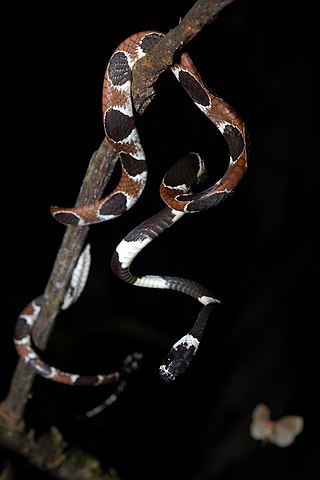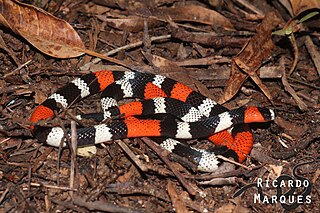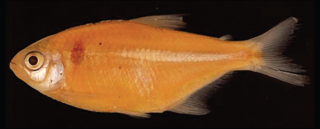The dotted brown snake is a genus of the Colubridae family of snakes. It is monotypic in the genus Sordellina. It is endemic to Brazil.

Dipsas is a genus of nonvenomous New World snakes in the subfamily Dipsadinae of the family Colubridae. The genus Sibynomorphus has been moved here. Species of the genus Dipsas are known as snail-eaters.

The Brazilian coral snake is a species of coral snake in the family Elapidae.

Micrurus ibiboboca, the caatinga coral snake, is a coral snake in the family Elapidae. It occurs in eastern Brazil, south of the Amazon.

Echinanthera cephalomaculata is a species of snake in the family Colubridae. The holotype measured 561 mm (22.1 in).

Helicops carinicaudus is a species of snake in the family Colubridae. It is endemic to eastern Brazil. Specimens from Colombia are likely mislabeled, probably representing Helicops danieli.

The Brazilian burrowing snake is a snake endemic to Brazil. It is monotypic in the genus Gomesophis.
Ihering's snake is a snake endemic to Brazil. It is the only species in the monotypic genus Lioheterophis.
The fanged water snake is a genus of snake in the family Colubridae.

Atractus trihedrurus is a species of snake in the family Colubridae. In English the species goes by the common name southern ground snake.

Epicrates assisi is a species of snake in the family Boidae. The species is endemic to Brazil.
Atractus altagratiae is a species of snake in the family Colubridae. The species can be found in Brazil.
Atractus hoogmoedi is a species of snake in the family Colubridae. The species can be found in Brazil.
Atractus potschi is a species of snake in the family Colubridae. The species can be found in Brazil.
Amnisiophis amoenus is a species of snake of the family Colubridae.

Sauvage's snail-eater, is a non-venomous snake found in Brazil.
Jan's snail-eater, is a non-venomous snake found in Brazil.

Dipsas mikanii is a non-venomous snake found in Argentina, Paraguay, and Brazil.
Dipsas neuwiedi, Neuwied's tree snake, is a non-venomous snake found in Brazil.

Deuterodon sazimai is a small freshwater fish endemic to a handful of river basins in southeastern Brazil. Upon being first described, it was considered a member of genus Probolodus; Probolodus is now considered obsolete, synonymized with Deuterodon. Much like other members of Deuterodon, and like some species in related genera like Astyanax or Jupiaba, D. oyakawai is a silvery fish with fins in some combination of red and clear. It sports a wedge-shaped humeral spot, and an oval-shaped blotch on its tail joint.











